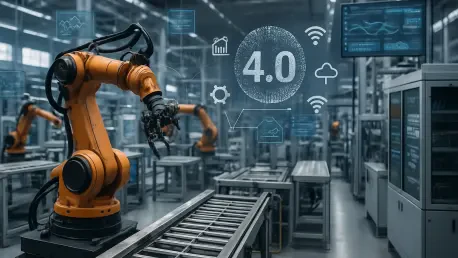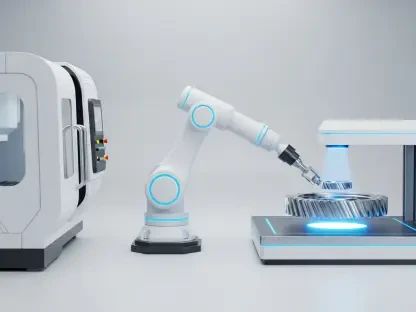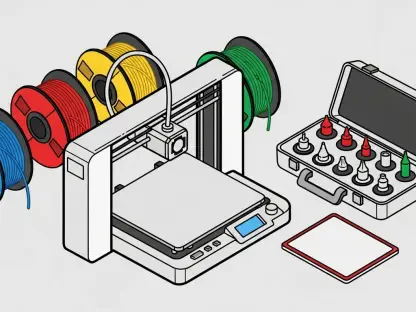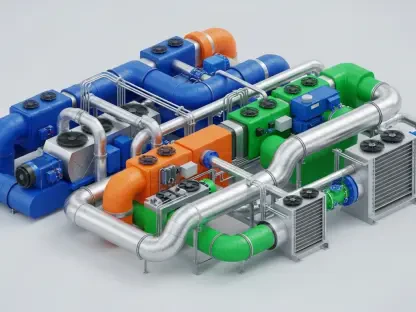Australia’s Industry 4.0 market is on the brink of a transformative decade, marked by substantial growth driven primarily by technological innovations and strategic government interventions. This market, which refers to the fourth industrial revolution, is characterized by the integration of advanced technologies such as artificial intelligence, machine learning, Internet of Things (IoT), robotics, and digital twins. These technologies are reshaping industries by enhancing productivity, improving operational flexibility, and elevating efficiency across various sectors. The projected increase from USD 3,294.00 million in 2024 to USD 11,142.25 million by 2033 exemplifies a significant leap that reflects both challenges and opportunities in technology adoption and infrastructure development.
Technological Catalysts of Growth
Role of 5G Networks
One of the most significant driving forces behind Australia’s Industry 4.0 market growth over this period will be the widespread deployment of 5G networks. By providing high-speed, low-latency communication capabilities, 5G technology is revolutionizing industrial communication and enabling real-time data exchange, which is crucial for effective digital transformation. In particular, manufacturing and industrial sectors are expected to benefit immensely from the seamless integration of machines, sensors, and systems that 5G facilitates. This connectivity is fostering new levels of automation and permitting instantaneous data-driven decisions, thereby streamlining operations and enhancing productivity.
Moreover, 5G networks are pivotal in advancing digital twins, a technology that uses virtual models to accurately reflect physical objects. The real-time capabilities of 5G allow for the continuous updating of digital twins, enabling companies to simulate, predict, and optimize performance in real time. This not only aids in operational efficiency but also enhances maintenance and troubleshooting processes by detecting issues before they manifest physically. Consequently, businesses that adopt 5G-supported technologies are better positioned to innovate and remain competitive in an increasingly digital world. The adoption of 5G technology is, therefore, a crucial element that could significantly lower costs, promote innovation, and drive Industry 4.0 forward between 2025 and 2033.
AI Integration and Its Implications
Artificial intelligence, another pillar of Industry 4.0, is increasingly being utilized in diverse industrial applications, ranging from predictive maintenance to quality control and supply chain optimization. AI technologies are enabling businesses to identify inefficiencies and predict potential system failures before they occur. This preemptive approach reduces downtime, safeguards assets, and optimizes resource management. In manufacturing, AI helps improve process accuracy and quality while offering valuable insights into production data. Consequently, Australian industries embracing AI are enhancing their operational capabilities and gaining a competitive edge in global markets.
Furthermore, the integration of AI technologies in logistics and supply chains is playing a crucial role in optimizing these sectors. AI aids in the real-time analysis of large data sets, enabling companies to respond swiftly to changing market demands and disruptions. This agility is essential for maintaining service excellence, especially in the face of unforeseen events that can impact supply chains. Additionally, as businesses continue to harness AI technologies for strategic inputs, they are poised to realize significant improvements in operational efficacy, contributing to the broader growth and adoption of Industry 4.0 practices throughout Australia. AI’s role in workforce optimization cannot be overlooked, as it augments human capabilities, allowing organizations to maximize employee potential and improve overall productivity.
Policy and Economic Dynamics
Government Support and Strategic Initiatives
Government support is a critical component propelling Industry 4.0 in Australia, underscoring the importance of collaborative initiatives and strategic investments. Through various funding programs, innovation hubs, and digital transformation initiatives, the government is committed to accelerating the adoption of advanced technologies across industries. These efforts are geared towards fostering a favorable environment for businesses to innovate and expand, in turn stimulating economic growth and job creation. By encouraging sustainable manufacturing practices and the circular economy, government policies are driving demand for data-driven solutions that improve energy efficiency and reduce waste.
In parallel, policy frameworks are setting standards and regulations that encourage the development of secure and resilient digital infrastructures. Addressing cybersecurity concerns is key to building trust and ensuring that industries can implement new technologies confidently. The commitment to workforce development is equally important, as the government provides training programs and educational initiatives designed to equip the workforce with skills vital for operating and managing these advanced technologies. By focusing on education, regulation, and infrastructure, Australian policymakers are playing a pivotal role in shaping a robust ecosystem conducive to Industry 4.0 advancement, with long-term implications for economic sustainability and competitiveness.
Economic Impacts of Technology Adoption
The economic landscape of Australia is poised to undergo significant transformations as a result of technology adoption within the Industry 4.0 framework. The integration of smart technologies, including IoT, robotics, and machine learning, is anticipated to increase productivity and efficiency across industries. Such advancements are crucial for businesses aiming to remain competitive in the global market. The focus on automation and strategic innovation supports operational enhancements while addressing labor shortages through increased reliance on technology.
Additionally, the emphasis on sustainable manufacturing processes is gaining momentum, with companies shifting towards eco-friendly practices to align with international environmental standards. Industry 4.0 technologies facilitate this transition by providing solutions that enhance resource management, decrease energy consumption, and minimize waste. The economic benefits are twofold: businesses not only achieve cost reductions but also enhance their corporate social responsibility image, thus remaining appealing to environmentally-conscious consumers and investors. The continuing shift towards sustainable practices further emphasizes the importance of embracing Industry 4.0 technologies for a resilient and prosperous economic future.
Challenges and Strategic Solutions
Addressing Infrastructure and Skills Gaps
Despite the promising outlook, Australia’s Industry 4.0 growth trajectory faces several challenges that require strategic attention. One of the primary issues is the need for robust infrastructure to support advanced digital technologies, particularly in regional and remote areas where connectivity remains limited. Investment in infrastructure development is essential for ensuring seamless integration and functionality of Industry 4.0 technologies nationwide. Bridging this digital divide is crucial to enabling uniform access to technological advancements, thus promoting equitable growth and opportunities across all regions.
In addition to infrastructure, the skills gap poses another significant hurdle in the adoption of Industry 4.0 technologies. The complexity of technologies such as robotics, AI, and data analytics necessitates a highly skilled workforce capable of implementing, managing, and optimizing these systems. As such, investments in education and workforce development are imperative. Fostering strong partnerships between industry leaders, educational institutions, and government entities can address these skill shortages effectively. By implementing comprehensive training programs and promoting STEM education, Australia can cultivate a workforce equipped to harness the full potential of Industry 4.0.
Mitigating Implementation Costs and Cybersecurity Threats
Another important consideration for Australia’s Industry 4.0 progression is the high initial cost associated with technology implementation. While smart technologies promise long-term cost savings and efficiency gains, the upfront investment required can be a barrier for small and medium-sized enterprises (SMEs). Solutions to this challenge involve financial incentives and support mechanisms, such as grants and tax incentives, to alleviate the financial burdens on companies aiming to embrace digital transformation. Furthermore, collaborative models and shared resources can help smaller businesses access technologies traditionally out of their reach, helping democratize the benefits of Industry 4.0.
The potential for cybersecurity threats also looms large as industries become more digitally integrated. Protecting sensitive data and ensuring the security of connected systems are fundamental to maintaining the integrity and reliability of operations. Companies must prioritize robust cybersecurity measures and protocols to protect against breaches and cyberattacks. This requires not only technological solutions but also fostering a culture of awareness and preparedness within organizations. By proactively addressing cybersecurity concerns, industries can build resilience against potential threats, thereby enabling a safe and seamless transition into the era of Industry 4.0.
Strategic Opportunities and Future Outlook
Embracing Predictive Maintenance and Smart Factories
Among the strategic opportunities presented by Industry 4.0, predictive maintenance and the development of smart factories stand out as particularly promising avenues. Predictive maintenance leverages advanced sensors and data analytics to monitor equipment condition in real time, allowing for proactive maintenance efforts that can prevent costly breakdowns and extend the lifespan of machinery. By minimizing unplanned downtime, organizations can significantly enhance productivity and efficiency, thus realizing considerable cost savings and operational improvements. This approach is especially valuable in sectors where equipment reliability is paramount, such as manufacturing and energy.
The concept of smart factories—a key component of Industry 4.0—holds transformative potential for manufacturing processes. By integrating IoT, AI, and robotics, smart factories are characterized by their ability to operate autonomously, optimize resource use, and adapt to changing conditions seamlessly. These intelligent production environments facilitate flexible manufacturing and enable rapid reconfiguration in response to market demands. Consequently, companies can achieve greater operational agility, improved product quality, and reduced lead times, all of which contribute to enhanced competitiveness in the global market. Investing in the development and implementation of smart factory solutions is an essential step for organizations aiming to capitalize on the benefits of Industry 4.0 fully.
Pioneering Sustainable Manufacturing Practices
As sustainability becomes a central focus in industrial development, Industry 4.0 technologies offer innovative solutions for adopting eco-friendly manufacturing practices. By leveraging data-driven insights and advanced automation, businesses can optimize resource utilization, reduce energy consumption, and minimize waste generation. This transition toward sustainable practices is motivated by both environmental concerns and growing consumer demand for environmentally responsible products. Companies that embrace green manufacturing strategies strengthen their market position and enhance their brand reputation among eco-conscious consumers.
Industry 4.0 facilitates the development of a circular economy, where resources are used more efficiently and waste is minimized through recycling and reusability. This approach aligns with broader global trends toward sustainability and offers significant economic and social benefits. By integrating Industry 4.0 technologies into their operations, Australian companies can reduce their environmental footprint while improving cost-effectiveness and resource efficiency. The commitment to sustainable manufacturing not only contributes to the preservation of natural resources but also reinforces Australia’s position as a leader in innovative, responsible industrial practices.
Conclusion
Australia is on the cusp of a transformative decade as its Industry 4.0 market, exemplifying the fourth industrial revolution, undergoes substantial advancement. This growth is fueled by technological breakthroughs and strategic government actions. Industry 4.0 is defined by the integration of cutting-edge technologies, including artificial intelligence, machine learning, Internet of Things (IoT), robotics, and digital twins. These advancements are revolutionizing various industries by boosting productivity, enhancing operational flexibility, and improving overall efficiency. As a result, the market’s projected expansion from USD 3,294.00 million in 2024 to USD 11,142.25 million by 2033 represents a remarkable growth trajectory. This significant leap reflects the challenges and opportunities associated with the adoption of new technologies and the development of supportive infrastructure. Additionally, the transformation signals a shift towards more sustainable and competitive industrial practices, fostering innovation and economic growth throughout Australia.









